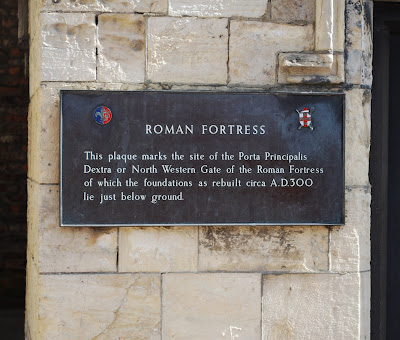Our next two bits of heraldry are coats of arms that we have seen before (along with another, new one that we'll be seeing more of later), but I'm giving them their own post because they are located on the "shortest street in York", the one with the unusual name.
Back in 1505, it was called "Whitnourwhatnourgate", meaning "What a street!"
Sometime later, it was changed to Whip-Ma-Whop-Ma-Gate. As being easier to pronounce, I suspect. (And just in case you think I might be making this up, here's one of the helpful location and direction signs posted there.)
Still, as I stated in the title to this post, I think those words, or at least those syllables, don't mean the same thing in York as they might here in Texas, where they could be taken to mean one should whip, or whop, or both, one's "Ma", or mother, at a gate.
But of course, we're here not to talk about the morality, or immorality, of whipping one's mother at a gate. We're here for the heraldry, which can be found on two other signs at the street.
The first, which we have seen before, is the arms used by the City of York Council, here placed on a sign near a bicycle stand explaining the best ways to lock up your bike to prevent its theft.
The other, on an historical marker, contains both the arms of the City of York (Argent on a cross gules five lions passant guardant or) with the cap, sword, and mace on the upper right, and on the upper left, a new bit of heraldry for us, the badge of the York Civic Trust, Azure a fleur-de-lis or dimidiating Gules a crowned leopard's face or.
Please feel free to click on any of the images above to see a larger, more detailed photograph of these signs.
The badge of the York Civic Trust (the Trust says its vision is "promoting heritage, shaping tomorrow") is based on the pre-Stuart Royal Arms of England, Quarterly: 1 and 4, France modern (Azure three fleurs-de-lis or); 2 and 3, England (Gules three lions passant guardant in pale or).
I think you might be hard-pressed to say "historic York, England" more concisely than with these last two pieces of armory.
I could be wrong, but I don't think so.

















































